We still need $110 to meet our deficit by the first. If you can afford it, please donate off to the right of this blog. Help us keep going until we can build our business to meet that deficit ourselves. Thank you and God Bless you in a very special way today. We are very grateful for all who have aided us so far in so many ways.
Vatic Note: This one below is awesome. Its about the Knights Templar, the Rennes le Chateau and the village and church that was built there. The priest who ran the property, Fr Saunier, knew more than anyone about the church, the "treasure" that was held there in hiding, and the story of the entire life of the knights Templar and the vatican.
I did not know half of what I read here, however, I had done an enormous amount of reading about the Knights, and the Cathays, who were massacred by the Catholic Church. The "treasure" that the priest found was in fact documents and not treasure, and these documents are the "discovery" this section talks about. Very very interesting read and it explains a lot.
The Dragon Society Real History, Dragon Philosophy and The Importance of Royal Bloodlines, Part 4 of 6 - "The Discovery"
http://web.archive.org/web/20040613000506/www.thedragonsociety.com/TheDiscovery.html
by Tracy Twyman
Rennes-le-Château is a village situated on a mountain peak 25 miles from Carcassonne in southern France. A few miles away there is another mountain called Bézu on which there stand the ruins of a former centre of the Knights Templar. About a mile east from Rennes-le-Château are the ruins of the castle of the Blanchefort family, and the home of Bertrand Blanchefort, the fourth grandmaster of the Knights Templar.
The Knights Templar are the so-called Warrior Monks who were proclaimed by Pope Innocent II in a Papal Bull in 1139 to owe allegiance only to the Pope, and were therefore under no obligation to kings and princes. Effectively they constituted an autonomous international empire.
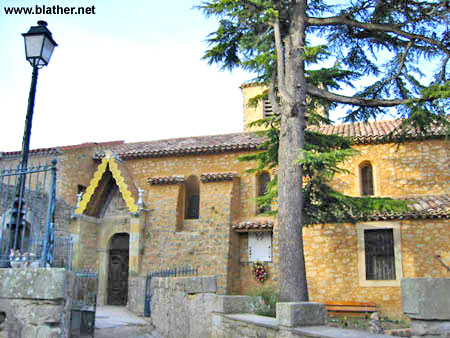
The church at Rennes-le-Château
Bérengere Saunière, the priest of Rennes-le-Château, decided to partly renovate the church the village church in 1891. It had been consecrated to Mary Magdelene in 1059, and was built on the site of a Visigoth church that dated back to the sixth century. When the altar stone was removed, Saunière found that one of the pillars that it stood on was hollow.
Inside this column were four parchments kept in two sealed wooden tubes. Two of them were apparently genealogies. One dated from 1244, and the other from 1644. The two others had been written in Latin by one of Saunière´s predecessors, Abbé Antoin Bigou, who had been personal priest to the Blanchefort family – important landowners in the area.
These parchments dated from the 1780s, and seemed to be written excerpts from the New Testament in Latin. However, in one of the parchments, the words were written without spaces and extra, at first sight, unnecessary letters had been added. In the second parchment, some letters had been raised above the others. The following decipherment has appeared in French documents written about Rennes-le-Château, and the book The Holy Blood and the Holy Grail by Michael Baigent, Richard Leigh and Henry Lincoln, and the BBC films that they made on the subject.
BERGERE PAS DE TENTATION QUE POUSSIN TENIERS GARDENT LA CLEF PAX DCLXXXI PAR LA CROIX ET CE CHEVAL DE DIEU J’ACHEVE CE DAEMON DE GARDIEN A MIDI POMMES BLEUES
which translates as:
SHEPHERDESS, NO TEMPTATION THAT POUSSIN, TENIERS, HOLD THE KEY; PEACE 681, BY THE CROSS AND THIS HORSE OF GOD I COMPLETE - or DESTROY - THIS DAEMON OF THE GUARDIAN AT NOON, BLUE APPLES
Rather more obvious in the second parchment is the following, spelled out in raised letters:
A DAGOBERT II ROI ET A SION EST CE TRESOR ET IL EST LA MORT
which translates as:
TO DAGOBERT II, KING, AND TO SION BELONGS THIS TREASURE AND HE IS THERE DEAD
Saunière realized that he had stumbled upon something important, and therefore took the parchments to the Bishop of Carcassonne. He was immediately ordered to go to Paris, at the Bishop’s expense, where he met various important ecclesiastic authorities. During the three weeks that he spent there, Saunière was accepted into the circle of Émile Hoffet, the nephew of the Director General of the Seminary of Saint Sulpice. Hoffet was training for the priesthood, and was a well-respected scholar of linguistics, cryptography and palaeography.
He was also involved in esoteric, occult groups, which included the writers Stéphane Mallarmé and Maurice Maeterlink, as well as the composer Claude Debussy. The famous opera singer, Emma Calvé, also mixed in these circles, and is reputed to have had an affair with Saunière, or at least a very close friendship with him. While there, Saunière bought reproductions of three paintings from the Louvre, one of which was Les Bergeres de Arcadie - The Shepherds of Arcadia by Nicolas Poussin.
When he returned to Rennes-le-Château, he continued renovations on the church, and he discovered a burial chamber in the church that, it is said, contained skeletons. He also turned his attention to the sepulchre of Marie, Marquise d’Hautpol de Blanchefort. This had been designed by Abbé Antoin Bigou, and the rearranged letters on the inscription formed an anagram of the code above referring to Dagobert II.
Saunière, for no explained reason, obliterated the inscription, but did not realize that it had been copied elsewhere. He developed the habit of wandering around the countryside with his housekeeper, Marie Denarnaud, collecting stones and rocks. He was also in correspondence with people all over the world, and spending a large amount of money on postage alone. Needless to say, this was abnormal behaviour for a humble priest in the French countryside.
He was extravagant in many other ways too. A road was built leading up to the village, and the Tower of Magdala was built. A new house was built – Villa Bethania - which Saunière never occupied. The church was decorated in an opulently bizarre way. Over the porch was put the inscription:
TERRIBILIS EST LOCUS ISTE
which translates as:
THIS PLACE IS TERRIBLE
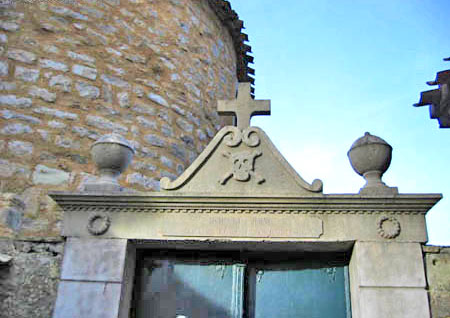
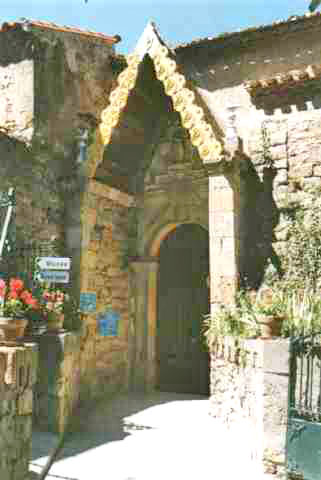
The church door
at Rennes-le-Château
Tracy Twyman points out in Dagobert’s Revenge,
"this is a quote from Genesis, where Jacob falls asleep on a stone and has a vision of a ladder leading up to heaven, with angels ascending and descending. This, of course, is the same Stone of Destiny brought to Scotland by Joseph of Arimathea, and became the stone upon which British monarchy are crowned, even today. What’s noteworthy is that beneath the words ’This Place is Terrible’ seems to be completed by the words in Latin ’but this is the House of God and the Gateway to Heaven’, making it not a curse, but a statement upon the dual nature of divinity."
Immediately inside the entrance to the church, Sauniere placed a statue of the demon Asmodeus - the demon in charge of secrets, guardian of hidden treasure and, according to Judaic tradition, the builder of the Temple of Solomon. He was also known as "the Destroyer", as well as "Rex Mundi", the "Lord of the Earth." Inside the church garishly painted Stations of the Cross were painted, and in some there are inconsistencies. For example:
in Station VIII there is a picture of a child dressed in Scottish tartan.
Station XIV depicts Jesus’ body being carried at night under a full moon in the vicinity of a tomb. It could mean that his body was being carried to the tomb at night, several hours after the Bible would have us believe. Or perhaps the body is being carried out of the tomb...
There are statues of five saints whose initials spell out G.R.A.A.L. (as in Holy Grail):
Saint Germain
In the shape of an "M". This "M" has been supposed, for reasons that will later become apparent, to stand for "Magdelene".
Reference is also made for the first time by Tracy Twyman in Dagobert’s Revenge that,
"the church wall featured the telltale marking, a yellow stripe embedded in the foundation, which was used in those days to indicate that as early as the 8th century someone of royal blood was buried inside the church."
And Saunière continued to spend. He had a magnificent library installed in the Magdela Tower that he had constructed, he built an orangery and a zoological garden and accumulated valuable collections of china, fabrics and antiques. His parishioners were treated to huge banquets and received visits from various well-connected figures.
The most noteworthy of his visitors was Archduke Johann von Hapsburg, a cousin of Franz-Josef, emperor of Austria. According to banking records, the Archduke paid considerable amounts of money over to Saunière.
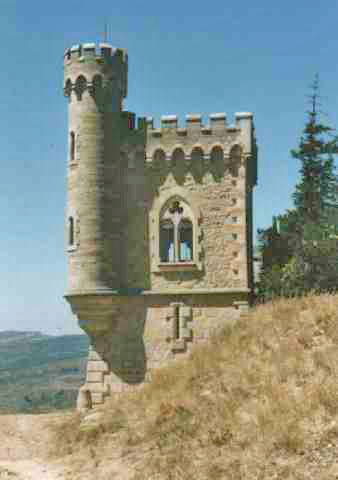
The Tower of Magdela
Although the church turned a blind eye to these goings-on, it reached a point when the bishop of Carcassonne had to act, and he summoned Saunière to make an account of himself and his dealings. He accused Saunière of simony, that is, the selling of masses. Saunière flatly refused to reveal anything, and the Bishop therefore suspended him. However, Saunière appealed to the Vatican, and he was re-instated.
Then on January 17th, 1917, at the age of 65, Saunière had a sudden stroke. The date is of interest. It is the same date as the death of Marie, Marquise d’Hautpol de Blanchefort, whose tomb inscription Saunière had obliterated. It is also the feast day of Saint Sulpice who crops up again and again in this account.
Of particular significance, however, is that five days before his death, on January 12th, Saunière appeared to his parishioners to be in good health. But this was the day that his housekeeper, Marie Denarnaud, ordered his coffin. The priest who heard Saunière’s deathbed confession, according to some, "never smiled again" and he refused to give Saunière the last traditional Roman Catholic rites of extreme unction.
Saunière died on January 22nd. His body was sat upright in an armchair on the terrace of the Tour Magdala. He was dressed in an ornate robe with scarlet tassels attached. One by one unidentified mourners filed past his body, and some took a tassel off the robe. Nobody has ever been able to explain this odd procedure.
To the astonishment of everyone, when the will was read, Saunière was discovered to have died penniless. Shortly before his death, he had transferred all his money to his housekeeper. It is possible that she had been in charge of the money all along.
After the Second World War, the French government introduced a new currency, and all citizens were obliged to exchange their old francs for the new ones. Large amounts of money had to be accounted for in order to trace "black" money saved by collaborators, tax-evaders and the like. Marie Denarnaud would not reveal the source of her money, and was to be seen later burning large amounts of cash in the garden of the Villa Bethania.
She eventually sold the house to Monsieur Noël Corbu, and told him that before she died she would tell him a great secret, which would make him not only very rich but also very powerful. Unfortunately, much to the chagrin of Monsieur Corbu, on January 29th, 1953, she, like Saunière, suffered a sudden stroke, and was rendered speechless and prostate on her deathbed.
Where the money could have come from
The obvious question that springs to mind is where did Saunière’s money come from? The village and the surrounding area had been the centre of considerable activity from the time that the Celts designated it to be a sacred site to the time when the Cathars were persecuted in the 11th century.
There had been tales of hidden treasure throughout this time, and the Cathars especially were suspected of being the possessors of the "Holy Grail". The Knights Templar also were thought to have hidden treasure in the area, and Bertrand de Blanchefort organized excavations there. The Merovingian kings ruled much of modern France from the 5th to the 8th centuries, and Dagobert II, who was one of them, married a Visigoth princess. Rennes-le-Château was, at that time, one of the major centres of the Visigoths. The Visigoths themselves had considerable treasure accumulated from their pillaging of Europe, and in particular most of the wealth of Rome in 410 A.D..
Saunière could have discovered any of this, but the nature of the treasure appears to one’s instincts to be more that of a secret. Otherwise certain factors, such as the introduction he received to the Parisian intelligentsia from Hoffet, and the intense interest that the church took in the matter. It also doesn’t explain why the priest refused to give Saunière the sacrament of extreme unction, and why he was visited by, for example, the Archduke Johann Salvator von Habsburg.
The Archduke renounced rights to his titles in 1889, and was banished from the Austrian Empire. Treasure of "mere" monetary worth would also not explain the codes in the parchments and on the tomb of Marie, Marquise d’Hautpol de Blanchefort. Also Marie Denarnaud said that the secret she took with her to the grave involved not only money, but power. The money that Johnann Salvator von Habsburg paid over to Saunière came perhaps from another source. The Vatican treated Saunière very carefully in the latter years of his life. Could it be that the money came from the Vatican in order to silence him?
The Mystery Deepens
When The Holy Blood and the Holy Grail first came out, the authors received a letter form a retired Anglican priest who claimed that he had "incontrovertible truth" Jesus Christ did not die on the cross and could have lived to as late a date as 45 A.D..
On being interviewed, he claimed that he had been told the information by another Anglican priest, Canon Alfred Leslie Lilley. Throughout his life, Lilley had maintained contact with the Catholic Modernist Movement that was based at Saint Sulpice in Paris, and he had known Émile Hoffet. The authors felt that this connection added authenticity to his claim.
The French painter, Nicolas Poussin, also appears to play a rôle in this account. He was visited in Rome by Abbé Louis Fouquet, the brother of Nicholas Fouquet, the Financial Superintendent to Louis XIV of France, in 1656. After the meeting the Abbé wrote to his brother. Part of the letter reads:
"He and I discussed certain things, which I shall with ease be able to explain to you in detail - things that will give you, through Monsieur Poussin, advantages which even kings would have great pains to draw from him, and which, according to him, it is possible that nobody else will ever be able to rediscover in the centuries to come. And, what is more, these are things so difficult to discover that nothing now on this earth can prove of better fortune nor be their equal."
Nobody has been able to explain the rather cryptic message in this letter, but the fact is that shortly after receiving this letter, Nicholas Fouquet was imprisoned for life in solitary confinement. It has been suggested that he was the model for The Man in the Iron Mask. All his correspondence was confiscated, and handed over to Louis XIV who read it only in private. Louis XIV went to great lengths to buy Poussin’s painting, Les Bergers d’Arcadie which he had hidden away in his private apartments at Versailles.
You will recall that it is a copy of this painting that Berenger Saunière buys at the Louvre during his visit to Paris.
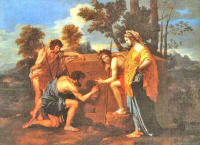
The painting depicts a large ancient tomb with three shepherds and a shepherdess in the foreground. The setting is of a rugged landscape that is typical of Poussin. The inscription on the tomb reads:
ET IN ARCARDIA EGO
The landscape had always been assumed to be a product of the artist’s mind. However, in the 1970s, an actual tomb was located which was identical in shape, dimensions, vegetation, background and setting. There is even rocky outcrop that is identical to that one which one of the shepherds rests his foot. If you stand just in front of the tomb, you will see that the view is exactly the same as the one in Poussin’s painting. The corresponding peak in the background is that of Rennes-le-Château.
The tomb is located just outside a village called Arques, 6 miles from Rennes-le-Château and 3 miles from the château of the Blanchefort family. There is no indication of the age of the tomb. The village records state that the land surrounding the tomb belonged to an American who opened the sepulchre in the 1920s and found it to be empty. He died in the 1950s and was later buried in it with his wife.
Which brings us back to the inscription on the tomb in Poussin’s painting. It appears to not make much sense, as it lacks a verb:
The tomb is located just outside a village called Arques, 6 miles from Rennes-le-Château and 3 miles from the château of the Blanchefort family. There is no indication of the age of the tomb. The village records state that the land surrounding the tomb belonged to an American who opened the sepulchre in the 1920s and found it to be empty. He died in the 1950s and was later buried in it with his wife.
Which brings us back to the inscription on the tomb in Poussin’s painting. It appears to not make much sense, as it lacks a verb:
And in Arcadia I…
However, an anagram of the inscription reads
I TEGO ARCANA DEI
which means:
Perhaps the mayor of Rennes-le-Château was correct when he said to Tracy Twyman last year, "This place is the centre point of the world."BEGONE! I BEHOLD THE SECRETS OF GOD
Now go to The Conclusion to read some of the conclusions that have been reached.
Of course, a subject of this magnitude cannot be covered adequately in an article of this length. We therefore recommend you to read The Holy Blood and the Holy Grail by Michael Baigent, Richard Leigh and Henry Lincoln from which we researched much of the information given here.
The article is reproduced in accordance with Section 107 of title 17 of the Copyright Law of the United States relating to fair-use and is for the purposes of criticism, comment, news reporting, teaching, scholarship, and research.

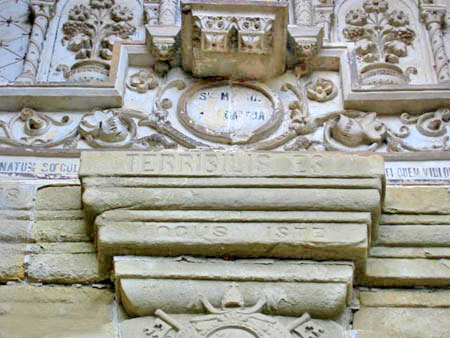
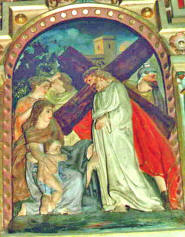
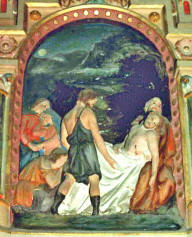
No comments:
Post a Comment